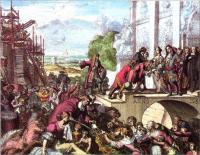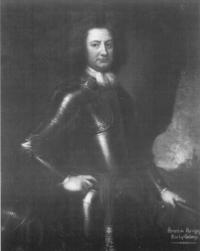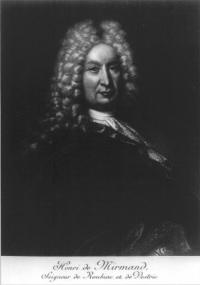Le Projet d’Irlande’: Huguenot migration in the 1690s by Randolph Vigne
Published in
Early Modern History (1500–1700),
Early Modern History Social Perspectives,
Features,
Issue 2 (Summer 1994),
Volume 2

Tyrannies towards the Protestants of France by or in the style of Romeyn de Hooghe.
(COURTESY OF THE ATLAS VAN STalK, ROTIERDAM)
It must have seemed a God-given set of circumstances: in Ireland after the Williamite war many areas of depopulated and unproductive countryside; in Europe several hundred thousand displaced persons ready to migrate with their families, their small means and considerable skills. And to fit the two together were three key people: the begetter of ‘Ie projet d’Irlande’, Huguenot general Henri de Ruvigny, now Lord Galway after his defeat of James II’s French general St Ruth at Aughrim; Henri de Mirmand, his Huguenot agent in Switzerland; and William of Orange himself. ‘The king’, Galway told de Mirmand, ‘is so affected by the misery which menaces these [Huguenot refugee 1 families and understands so well the utility of such a colonisation to his kingdom of Ireland that he is resolved to spend as much money as shall be judged necessary.’ That was in January 1693, a year which was to see Galway’s great project blossom, as rulers, agents, refugees and host governments shared a common will to fill the empty spaces Galway claimed to have seen in 1691 in war-ruined Ireland with seemingly ideal settlers. The Huguenots (French Protestants) had been fleeing from religious persecution since Louis XIV had revoked the Edict of Nantes in 1685: now they could be brought together in a new homeland. That the success of the scheme involved the introduction of a Protestant population into a predominantly Catholic country seems never to have been addressed.
‘Commission d’iriande’
More than a year earlier Galway and de Mirmand had agreed that the refugees stranded in Geneva and the Swiss cantons should be the first to move. While some preferred to await, in vain as it turned out, their imminent return to France, thousands of others were willing to go and a ‘Commission d’Irlande’ was set up. The scheme required the transporting of the refugee population first from the Swiss cantons and later from Holland, Germany, Scandanavia and some from Britain to Ireland’s allegedly open spaces, towns and villages, where houses and the wherewithal of trades and livelihoods must await them. King William pledged the funds and Galway set about planning the operation. The lord lieutenant, Sidney (later Lord Romney), and the Irish privy council were committed to the scheme but it was left to Galway to get the preliminary work done. He began by commissioning reports from three of his officers: Jacques de Belrieu, Baron de Virazel; the obscure de Cissay; and Charles Perrault de Sailly, a young Burgundian who had settled in Cassel, later joined Duquesne’s abortive scheme to establish a Huguenot colony in the Mascarenhas islands in the Indian Ocean, and who ended up in Ireland as an infantry captain. His is the only report to survive.

Henri de Massue de Ruvigny, Earl of Galway. (COURTESY OF THE OWNER)
De Sailly’s report
De Sailly went south and west to Carlow, Kilkenny, Waterford, Cork and Tipperary, finding numerous proprietors enthusiastic for his purpose. Travelling from Dublin through Naas and Castledermot he reported that Leighlinbridge in Carlow offered cheap houses and living, with fine farms and that the Barrow was good for transport and water power. Kilkenny was ‘en un bon pays, gras et fort bon air. Elle est joli, propre et bien biiie.’ The rooms and hall of a particular ‘grand maison’ were ideal for a college, but the cost of living was high, with white bread a penny a pound and black a halfpenny, meat twopence, butter threepence and candles fourpence. Only fish was really cheap. Callan he found a wretched little place in barren surroundings, whereas Clonmel, the ‘garden of Ireland’, found favour. Fethard was in ruins but was worth rebuilding, with its orchards, vineyards and ‘plusieurs joli fermes’. One hundred families could be settled at Cahir, a large and handsome village on the Suir, which could also be rebuilt, but the countryside around it was poor and deserted: ‘I saw hardly a soul or an animal for seven miles’. De Sailly found excellent prospects at Rathcormack and Kilworth, Castlelyons, Cork itself, Ovens, ‘Killercrew’, Castle Inchy on the Lee. Castlemore near the ancient castle of ‘Clowda’, and ‘Ballyglasskeen’. Macroom, capital of the barony of Muskerry, was ‘the Montpellier of Ireland because of its excellent air’. The land thereabouts belonged to the king and could by itself accommodate the 600 families that were earmarked

Henri de Mirmand.
(COURTESY OF THE HUGUENOT liBRARY, UNIVERSITY COLLEGE, LONDON)
to head the migration in 1693. He travelled on to Carrigadrohid, ‘un endroit sauvage dans les montagnes et les bois’, ‘Hanamuch’ and Blarney, where fifty gentlemen, each heading a district, could set up successful manufactures and plantations.On a second visit to Cork, where first he had met with the ‘governor’ and the nobility, he was impressed by its prospects in the manufacturing and meat trades (in the previous September and October alone, 48,000 beasts had been slaughtered for export to France and America). Bandon offered good prospects too and, as in Cork, there would be work in the merchants’ houses where the young Huguenot women could teach French and Latin as well as doing housework. Kinsale, though without any ‘Papistes’, was an ugly place and in ruins, unlike Cappoquin which was ‘attractive, agreeable and healthy, suitable for manufacturing, with plenty of water and well placed for selling its wares’. On 31 March 1693 de Sailly reached Waterford where word of the project had clearly preceded him. Four days earlier the city council resolved ‘to provide habitations for fifty families of the French Protestants to drive a trade of linen manufactures, they bringing with them a stock of money and materials for their subsistence till flax can be grown on the lands adjacent, and that the freedom of the city be given to them gratis’. De Sailly reported their offer, adding the need for physicians and surgeons, as at Cork and elsewhere, and many trades such as brewers, caterers, innkeepers, locksmiths, nailsmiths, sawmakers, ironmongers, gunsmiths and hatters, all of whom were lacking. Again colleges were needed, and they would in turn generate small shops and lodging houses and bring more trade to tailors and cobblers. On the road back to Dublin he saw possibilities in Thomastown on the Nore, and at Castledermot. De Sailly’s very favourable report was with Galway by 8 April, the same day Dublin privy councillors expressed their support for the project – adding the inevitable caveat ‘funds permitting’. Galway was still in Dublin and de Mirmand busy soliciting funds and transport from the States General in Holland. A Monsieur de I’Hermitage was left in charge in London while another key figure, the Marquis d’Arzeliers, based in Berne, was working to commit the Swiss cantons to moving the first 600 families to their borders. All looked set fair yet by mid-1693 the plan began to founder.
De Mirmand unenthusiastic
Despite Galway’s high opinion of him (‘I have never seen a man of greater sense or more zealous for the public good.’) de Mirmand proved to be an unenthusiastic agent. At a meeting at Breda the previous year, King William urged him to travel to London to lobby Godolphin, Nottingham and his other ministers to make available the necessary funds. But de Mirmand was reluctant to travel and was unwilling to sacrifice the comfort of his domestic life to accomplish his task. De Mirmand’s lack of enthusiasm and general pessimism, William’s deteriorating relations with his treasury lords, and the threat of war from William’s arch-enemy Louis XIV, al1 steadily undermined the project. The king dispatched Galway to Flanders where Huguenot regiments were needed. Galway wrote constantly to de Mirmand and the others, even from the battlefield. In July 1693 the Dutch States General voted the 40,000 florins asked of them, and in August the planners met in Baden, but the cracks were already showing. D’Arzeliers found the Swiss commissioners unwilling to start moving the refugees, whose miserable conditions were worsening, although money was beginning to arrive and Godolphin promised the £20,000 previously agreed upon. Another confidant, William’s unofficial envoy to Geneva, the Huguenot financier d’Herwart complained that the Swiss would not say yea or nay and that he was being harried from one part of Switzerland to another to try to get ‘notre peuple’ the freedom to start their journey.
Support crumbles
Then the blow fell. In July 1693 Godolphin and Southwel1 in London announced that English funds were being withheld and in the same month the Irish privy council withdrew their support for any immediate move. The season, they said, was too advanced, there was drought and famine in the country and the 600 families (over 3,000 individuals) could not be received until the fol1owing spring. Finally the Swiss also withdrew. The war had closed the Rhine, the water route to Hol1and, and Galway was again summoned to Flanders by the king, spending a hectic four days in London en route. Facing the ruin of the project he dispatched an aide-de-camp, Josue du Fay, from his camp near Louvain to take the bad news to de Mirmand, whose orders were still to get the refugees through to Hol1and and the coast. Du Fay returned to London with de Mirmand’s memoir to Godolphin, stressing the desperate plight of the 600 families, whom the Swiss would no longer support without the transfer of at least £2,000 from England. The money was never sent. In September 1693 William abandoned the project, to await better times, and the Swiss, with English, Dutch and German subsidies, managed to settle several thousand of the suffering Huguenots in the Bavarian towns of Schwabch and Erlangen, then part of Brandenburg-Baireuth.
Galway works on
Galway and his confidants worked on and it was not until after the Peace of Ryswick in 1697 that the project could be taken up again. In Ireland, Galway had made over his huge personal grant of the attainted Sir Patrick Trant’s 36,000-acre estate at Portarlington in leases to his soldiers (de Sailly and de Virazel among them) and their families. Several thousand more made their own way to settle in Dublin (the 280-strong Huguenot communityof 1692 had grown to 3,600 by 1720); in the thriving new settlements at some of the places advocated by de Sailly – Bandon, Clonmel, Cork, Kilkenny and Waterford; as well as in Belfast, Birr, Carlow, Castleblaney, Gorey, Lambeg, Lisburn, Wicklow and Youghal.
Among the settlers was Josue du Fay, who married a des Vignolles in London and later joined her large family circle in Dublin and Portarlington. The picaresque de Sailly’s role was not over. Many of the 500 Huguenots he took to Virginia with the Marquis de la Muce in 1700 suffered sickness and death on the James river. He managed to return and his son crops up among the London Huguenots of the 1760s as director of the venerable charity, the French hospital, La Province, of which Galway had been the founding governor.
No wide open spaces
De Mirmand, d’Arzeliers and d’Herwart still hoped to make Ireland the grand refuge of their fellow Huguenots but Galway had discovered a different Ireland from the apparently empty, devastated country of 1691. Despite de Sailly’s sanguine view, there were not the wide open spaces awaiting colonies of Huguenots. He wrote to the Dutch in 1698 that Ireland was ‘neither a conquered country nor one that has been newly discovered where land is to be found that is in no one’s possession. Every inch of the country has its proprietor’.
De Mirmand concludedthat ‘the great difficulty is not one of the money needed for such a considerable establishment, but the essential, insurmountable obstacle is that there is not one inch of land which does not belong to someone, whether as landlord or tenant’. When his own estate at Portarlington was taken away from him by the xenophobic Resumption Act of the English parliament in 1699, these inviolable leases held good and the thousands of other Huguenots who had come to Ireland partly at least under his benevolent protection stayed on to make new lives and offer productive citizenship to their new country.
De Mirmand concludedthat ‘the great difficulty is not one of the money needed for such a considerable establishment, but the essential, insurmountable obstacle is that there is not one inch of land which does not belong to someone, whether as landlord or tenant’. When his own estate at Portarlington was taken away from him by the xenophobic Resumption Act of the English parliament in 1699, these inviolable leases held good and the thousands of other Huguenots who had come to Ireland partly at least under his benevolent protection stayed on to make new lives and offer productive citizenship to their new country.
Randolph Vigne is Honorary Editor of the publications of the Huguenot Society of Great Britain and Ireland.
Further reading: C.E.J. Caldicott, H. Gough & J.P. Pittion, The Huguenots of Ireland: anatomy of an emigration (Dun Laoghaire 1987). G.L. Lee, Huguenot settlements in Ireland (London 1936, Baltimore 1993).



















